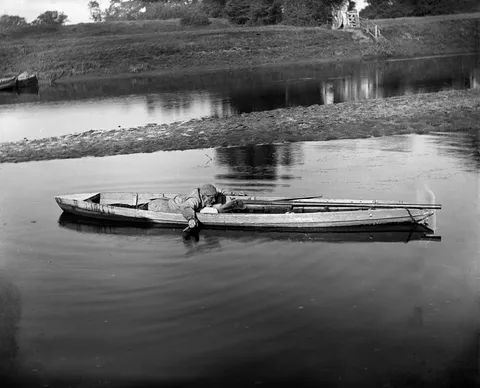The Lacey Act
Landmark legislation that helps protect wildlife to this day.

John Lacey, a US congressman from Iowa, introduced the Lacey Act, which passed both houses of Congress and was signed into law by Pres. William McKinley on May 25, 1900. The law bans trafficking in fish, wildlife, or plants that are illegally taken, possessed, transported, or sold.
Enacted at the turn of the 20th century, the Lacey Act was introduced by Iowa Congressman John Lacey, passed both houses of Congress, and was signed into law by Pres. William McKinley on May 25, 1900. The Lacey Act was a watershed piece of legislation, being the first comprehensive Federal law intended to protect American wildlife and ultimately eradicated market hunting in the United States.
At its heart, the Lacey Act criminalized the unregulated commercial trade of wildlife and wildlife parts. To fully understand the genesis and impact of the Lacey Act, you must first understand the sad state of American wildlife at the dawn of the 20th century. Westward expansion, habitat destruction, and market hunting had decimated wildlife populations. For example, when Europeans began settling America in the early 1600s, passenger pigeons numbered an estimated 5 billion. By 1901, they existed only in captivity and were completely extinct by 1914. As late as 1830, American bison numbered 40 million but by 1900 had been reduced to only 300. And many other species—-elk, deer, wild turkeys, and many predators—teetered on disappearing forever.
Early Hunting Laws
In the 1800s, hunting laws and regulations, at least in terms of defining seasons or bag limits, were basically non-existent. The first laws enacted by states were not hunting laws per se but simply limited the harvesting of a state’s wildlife resources to residents of that state. For example, Maryland enacted a law requiring a license to have a “sink box” for waterfowl hunting in the Susquehanna Flats—but only Maryland residents could obtain a license.
These laws, however, did not curtail the practice of “market hunting”—-hunting wild game for sale to millenary plants or birds and deer to restaurants for human consumption. It simply limited “market hunters” to residents of that particular state.
Eventually, individual states began to enact their own laws that set “bag limits”-—the number of a given species that could be lawfully taken-—and to prevent spring hunting of ducks, geese, and shorebirds, populations that had been significantly impacted by market hunting.
Many of these laws were facilitated by a new breed of urban “sportsman,” pioneering conservationists who saw the impact market hunting was having on wildfowl populations. Teddy Roosevelt and Aldo Leopold fall into this category and were instrumental in wildlife conservation and ultimately the North American Model of Wildlife Conservation (visit tinyurl.com/namodel).

Punt guns, such as the one seen here, were in heavy use among market waterfowl hunters in the late 1800s and early 1900s. The Lacey Act basically spelled the end of the punt-gun era, and the big shotguns were banned altogether in 1920.
Along Came Lacey
As more states began enacting laws excluding non-residents, setting seasons and bag limits, the demand for meat in restaurants and feathers in the ornamental-trade market grew, as did the price. Poaching was rampant—with little threat of prosecution or legal recourse. Non-residents would hunt illegally in one state, poach animals, then sneak back to a state where they could hunt legally—and sell their bounty—thwarting early efforts to prevent market hunting.
In 1900, the Lacey Act effectively ended such border jumping and market hunting by making it a federal crime “to import, export, transport, sell, receive, acquire, or purchase any [wild bird or mammal] taken, possessed, transported, or sold in violation of any law, treaty, or regulation ...” 16 U.S.C. §3372 (Prohibited Acts). Thus, it was no longer possible for a “poacher” to evade prosecution by simply slipping over the border into a “friendly” state.
The emergence of hunting licenses for both residents and nonresidents also helped, as did the Migratory Bird Treaty of 1916 (enacted in the US as the Migratory Bird Treaty Act in 1918), which made it illegal to sell any “migratory bird” (including ducks and geese).
Still in Effect
The Lacey Act is one of the primary enforcements the United States Fish & Wildlife Service uses to regulate the activities of hunters, outfitters, and citizens in general. For example, if a hunter goes to another state and illegally takes game, transports it across state lines, and is caught, it violates the Lacey Act. Or if a citizen picks up a king snake in his yard and sells it, it’s a violation of the Lacey Act. And ignorance of the law is no excuse. The Lacey Act has teeth, with penalties that can include felony charges.
Go here (tinyurl.com/laceycases) to read cases tried in court for violations of the Lacey Act.
Mike Oropallo is a partner and co-team leader of the Outdoor & Wildlife Team at Barclay Damon LLP. He has over 30 years of complex civil-trial experience, focusing on archery, the outdoor industry, and wildlife. He handles patent, trademark, and copyright matters for a wide variety of outdoor and archery clients.
This material is for informational purposes only and does not constitute legal advice or a legal opinion. No attorney-client relationship has been established or is implied
From the Spring 2022 issue of Guidefitter Journal.



